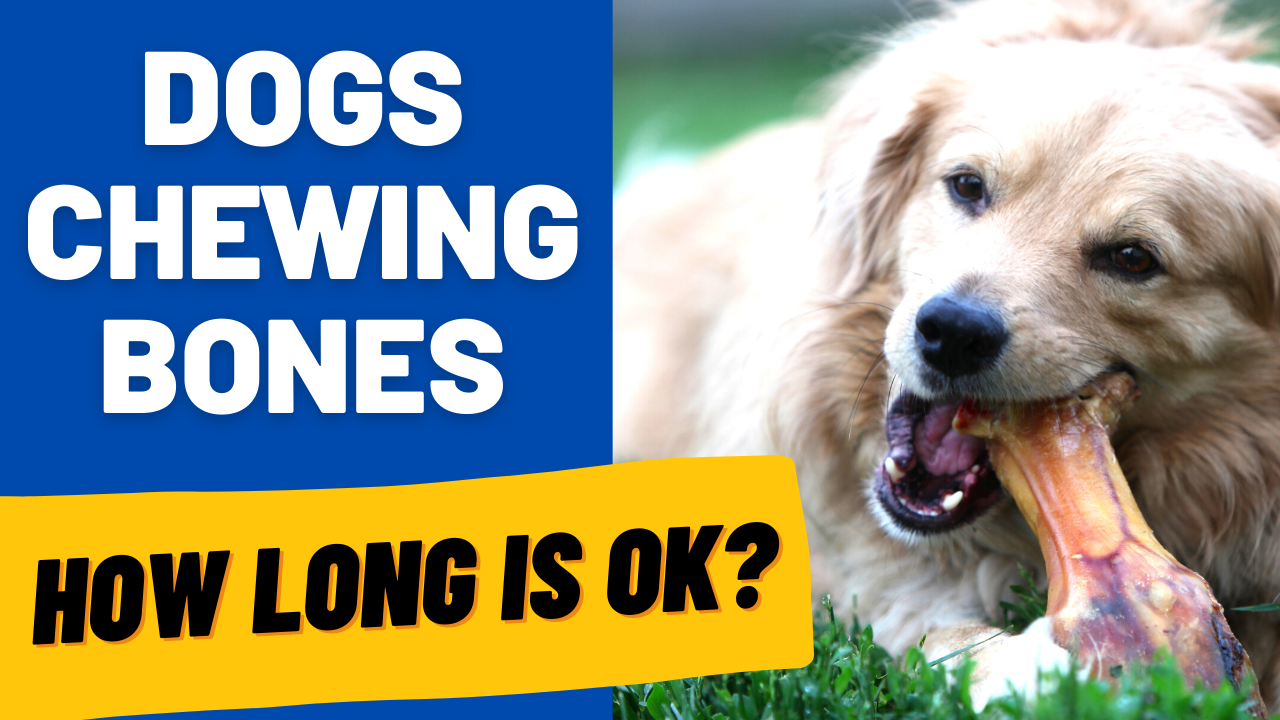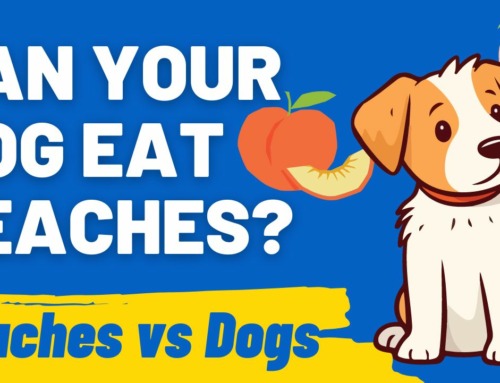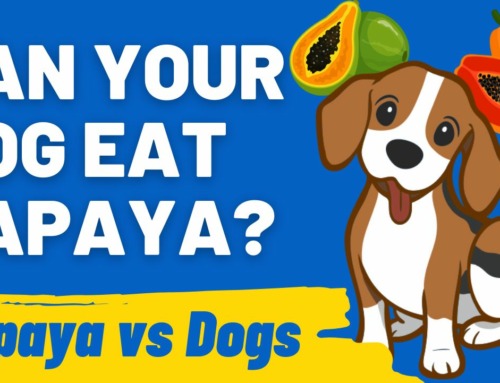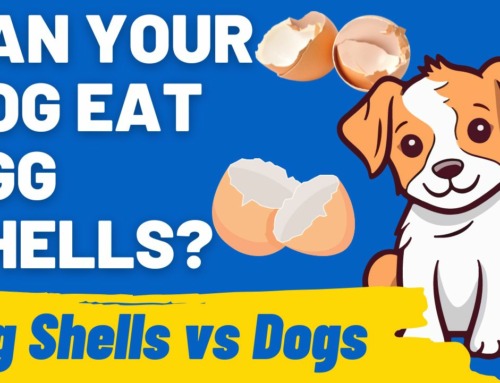The question of whether it’s okay for dogs to chew bones and for how long is hotly debated. Some pet parents and vets argue that bones can carry pathogens, or pose a health risk through choking, obstructing the intestines, or splintering. Bones have some risks, but they also come with many benefits. If you choose to feed your puppy meaty bones, let’s look at how long, how often, and how to safely give bones to your dog.
How long should you let your dog chew on a bone?
Most experts agree that about 15 to 20 minutes is enough chewing time on a bone. During this time, your dog can reap the benefits, such as removing the dental plaque on their teeth and enjoy the satisfaction of chewing. Chewing on a bone for longer than this risks whittling the bone down too far so that it becomes a choking hazard or potential bowel obstruction if they swallow it.
So always swap the bone for a toy, such as a puzzle toy, or treat after about 15 minutes and remove it.
You might like to read our post, The 20 Best Dog Enrichment Toys
Another possibility is that they ingest too much bone matter. This can cause an excess of calcium in their gut. Dogs who swallow too many bones often develop constipation and have white, crumbly poop.
Excess calcium can lead to other issues but is particularly dangerous for puppies, as it causes skeletal issues in growing dogs.
If you want to read more about the best dry foods for puppies, see our article here.
Remember to swap the bone for something else your dog likes when you take it away. Otherwise, you can cause them anxiety over having their bone removed, creating food aggression or resource guarding.
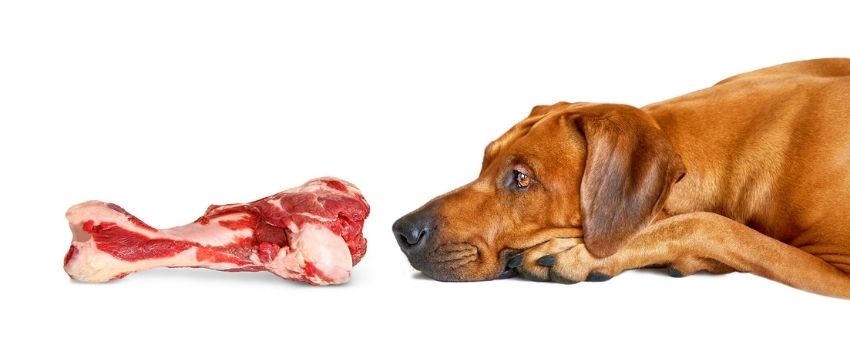
What kind of bones can I give my dog?
The best bone you can give your dog is a fresh, meaty hard marrow bone or spongy femur bone from a large animal like a cow or bison. The bone should be too big to swallow and removed before your dog gnaws it down.
Cooked bones and smaller bones are prone to splintering. Pig bones are more likely to carry pathogens, and poultry bones tend to be brittle and splinter. This is especially true of turkey bones that are highly hollow and sharp.
Bone shards slice your dog’s gums and cause vomiting or gastrointestinal damage. Dogs that eat cooked bones or poultry bones are likely to suffer from windpipe, gastrointestinal, or esophagus blockage upon the accidental swallowing of the bone.
Other health hazards associated with splinter consumption are rectal bleeding, choking, peritonitis (bacterial infection in the abdomen from stomach punctures), and mouth or tongue injuries.
You may wish to read this article, Dog Panting Heavily After Eating Bone, Bully Stick, Rawhide: Why?
Benefits of Chewing Bones for Dogs
Other than tapping into a dog’s natural urge to chew, bone chewing has several health benefits to go along with it, such as:
Improved Oral Hygiene
One of these benefits is improved oral health because chewing produces saliva enzymes that prevent plaque build-up. Bones keep your dog’s mouth clean by breaking down tartar and scraping off bacteria from the teeth.
Improved oral hygiene helps prevent dental issues like gum disease, leading to other severe health issues such as diabetes and heart disease. One study on beagles showed that dogs that are given spongy femur and hard marrow bones from a cow reduced dental plaque and calculus by 87.8 after 20 days.
Provides mental stimulation
Bones will keep your dog entertained and is also mentally stimulating. Mental stimulation is essential in preventing boredom and stress, leading to destructive behaviors like chewing on your furniture. The action of chewing also releases natural feel-good hormones that reduce stress and anxiety.
Source of much-needed nutrients
Raw bones are an excellent source of minerals and other nutrients. Minerals such as calcium and phosphorus are found in bones and in the correct ratio of 2:1 (Ca:P). The calcium found in bones can be up to 4 times more digestible than most calcium supplements.
In fact, bones are one of the most natural and bioavailable forms of many minerals, including magnesium.
Warning: Minerals such as calcium and phosphorus need to be balanced appropriately as part of a complete diet. Feeding a dog that already has a diet rich in calcium and phosphorus, more of it in bones, can lead to a range of health issues such as hyperparathyroidism or kidney problems such as calcium phosphate stones. Therefore, bones should only be part of a natural and well-balanced diet and are fed in moderation.
They help to minimize destructive chewing
The last thing you want is your shoes or furniture to be the object of your pup’s need to chew. Similarly, dogs can take excessive paw licking and other unwanted behaviors. This is especially true for anxious dogs and stressed dogs.
Bones are a safer chewing outlet to keep a dog occupied for a while and help them settle down. It’s a good idea to exercise your dog and then give them a bone to chew on for a while to help calm them before they need to settle for a nap or some crate time.
Aid in minimizing teething pain in puppies
Between 3 and 6 months, puppies experience pain and discomfort from losing their milk teeth. This is usually when your shoes, laptop chargers, and furniture become targets of your puppy’s incessant need to gnaw.
Putting bones in the freezer to cool them gives your puppy something cold to numb their gums, and the meaty taste of bones will divert them from other objects.
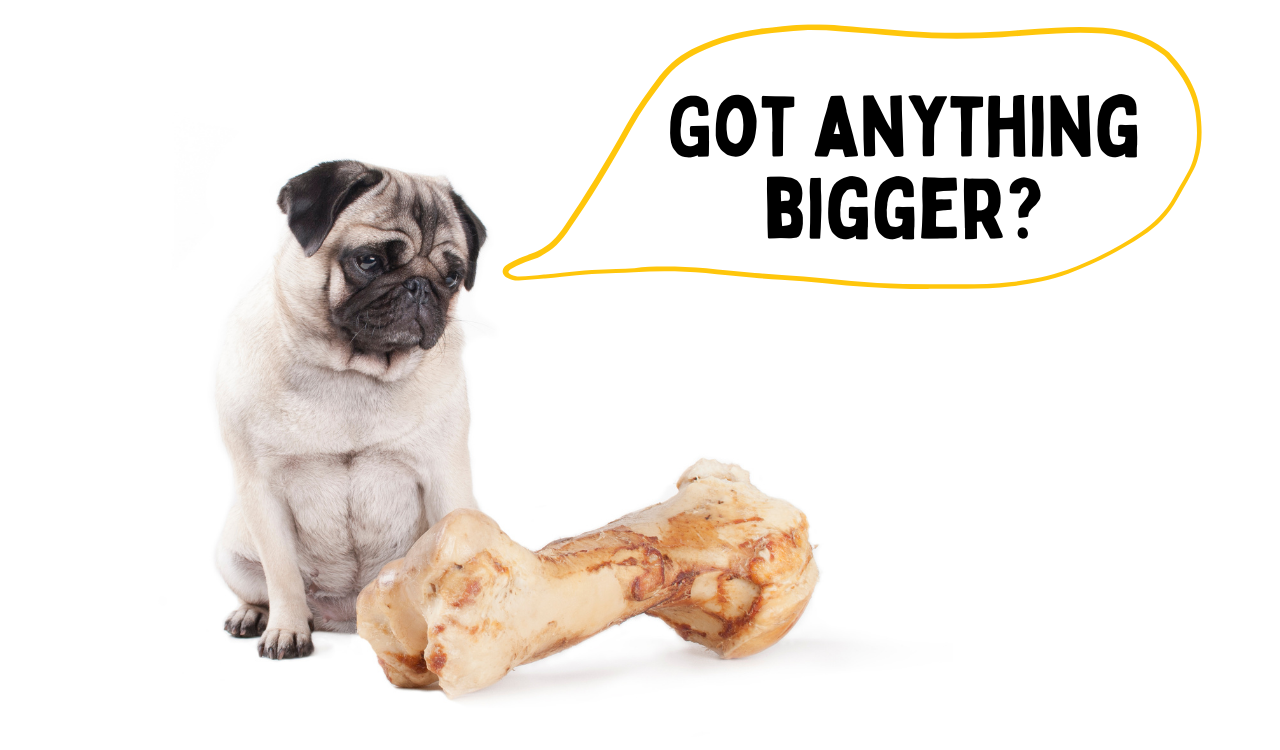
How to Give Bones to Your Dog Safely
With all the contradictory information about feeding bones to your dog, it’s essential to get your facts right to do it safely. If you are well-informed and follow these few simple rules, you should be able to find your way around giving bones to your dog correctly.
Step one: Find the right bone size and type of bone for your dog
One of the most important steps is finding the right bone size for your dog. A good rule of thumb is getting a bone the size of your dog’s head or bigger. The bone should be far too big for a dog to swallow and cause a choking hazard or an intestinal blockage.
Hard marrow bones from a cow are the best for puppies, as it is much tougher for them to wear down and ingest too much calcium and minerals. The marrow in the bone is also fun for them to try to lick out and has many healthy nutrients.
Keep in mind that the marrow is key here because chewing on something extremely hard, such as marrow bone, can cause teeth to break and splinter. This can lead to abscesses and infections.
Spongy femur bones remove more plaque and are better for dental hygiene. These are more suited to older dogs as it doesn’t wear down their teeth as much due to being softer. However, a dog will ingest more of this softer bone.
Step 2: Supervise your dog while they chew
All bones are choking hazards if they break apart. For this reason, you should monitor bone deterioration and take the bone away from your dog as soon as the size gets too small. Watching your dog closely as they chew also ensures that they don’t exceed the recommended 15 minutes of chew time.
Step 3: Give your dog the bone after they have eaten
A ravenous dog is more likely to swallow whole chunks of broken bone which can cause intestinal blockage. On the other hand, a satiated dog will simply enjoy the sensation of chewing, which reduces the risk of swallowing bits of bone.
Step 4: Stick to the recommended frequency
Dog owners frequently ask if dogs can chew bones too much, and the answer is yes. It might sound counter-productive to limit the intake of such a beneficial product, but too much of anything is a bad thing.
Make sure you stick to 15 minutes of chewing every day.
Anything more can cause bruising of the gums, leading to mouth diseases if left untreated. It is not okay to let your dog chew on bones for hours. It wears down their teeth, and too much-digested bone can cause health issues.
If your dog still needs something to occupy them, consider giving them filled frozen Kongs or softer chew toys.
Step 5: Practice good hygiene
Finally, remember you are dealing with a raw animal product that can carry pathogens. Be sure to only buy fresh cow or large venison bones from a reliable source.
Freeze any extra bones immediately. You can thaw them out overnight. Make sure bones are not old and don’t have any bad smell. Do not let them touch any surfaces they can contaminate.
Tip: always make sure your dog’s deworming schedule is up to date, especially if they have access to raw meat products.
Frequently Asked Questions (FAQ’S)
Can you give a dog a bone every day?
It’s best not to give a dog a bone every day. Giving your dog a bone every day is harsh to the teeth and could cause them to break. It also wears the teeth down over time and can cause an oversupply of calcium and phosphorus in their diet. It is recommended to give your dog bones two times a week for oral hygiene and mental stimulation.
Make sure to brush your dog’s teeth also and not only rely on bones for their dental health.
How long can your dog chew on an antler?
Antlers are long-lasting treats that can be given to your dog for 15 minutes at a time. Like marrow bones, antlers are extremely hard and can either splinter or break your puppy’s teeth. So keep an eye on them while they are busy with antlers and swap for a puzzle toy or treat when their time is up.
How long should your dog chew a rawhide bone?
A Chihuahua may take a lot longer than a Pit Bull to gnaw a rawhide into a state where it can be swallowed. So if your dog has powerful jaws, allow them about 10 minutes before swapping it out. If you have a smaller dog that isn’t in danger of wearing it down and swallowing a large chunk, you can leave them with it for up to 30 minutes.
Rawhide bones have the benefit of not being as hard on the teeth as bones are. However, they are typically bleached. If a dog swallows too much rawhide, it can cause intestinal blockage or gastrointestinal problems. Limit their time on a rawhide according to how fast they are able to soften and swallow it.
How long should your dog chew marrow bone?
A dog should spend no more than 15 minutes on a marrow bone. The chewing shouldn’t happen every day either; twice a week is enough. Marrow bones have many benefits, but they are extremely hard on a dog’s teeth and can damage the teeth.
Conclusion
Chewing the right bones is good for your dog as it cleans their teeth, keeps them busy, and is an experience they enjoy. However, it’s vital to supervise your dog when they eat bones and make sure they do it for no more than 15 minutes at a time.
Always choose safe, large bones, and when it’s time to remove them, swap the bone out for something else your dog enjoys, like a treat or toy.

